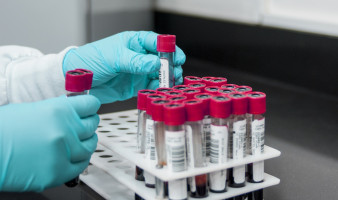
High-grade serous ovarian carcinoma (HGSOC) is the most common type of ovarian cancer.
It is also the most lethal form, in part because clinicians do not have effective ways to screen women for it during the cancer's early stages, when it's easiest to treat.
For patients with a pelvic mass (an abnormal lump or growth in the lower abdomen), it is difficult to detect whether the growth is benign or cancerous ahead of surgery.
Unlike many other cancers, biopsies are typically not an option.
That makes it hard for doctors to choose the best course of treatment.
Now, a new blood test called a liquid biopsy that detects specific nucleic acids circulating in the blood may be poised to change that.
Preclinical research just published in the journal Clinical Cancer Research suggests that this simple blood test may determine whether a pelvic mass is benign or cancerous at a better rate than existing tests.
"The test has the potential to improve treatment, because the surgical approach to removing a pelvic mass differs depending on whether it’s benign or not,” said Bodour Salhia, PhD, co-leader of the Epigenetics Research in Cancer Program at USC Norris Comprehensive Cancer Center and the study’s corresponding author.
"Right now, doctors essentially have to take their best guess."
Knowing more about the mass before surgery could point to which type of surgeon and which method of surgery is best for the patient, said Lynda Diane Roman, MD, an associate professor of obstetrics and gynaecology, division chief of gynaecologic oncology at the Keck School of Medicine and a co-author of the study.
In addition to helping healthcare providers choose the best treatment strategy for patients with a known pelvic mass, researchers will also investigate whether the new test, known as OvaPrint, can be used as a screening tool in the general population to detect early-stage ovarian cancer in asymptomatic women.
When ovarian cancer is found in its initial stages, patients have a more than 90% chance of living for five years or more.
Their chances drop to less than 40% if the cancer is detected in advanced stages.
"Early detection saves lives," said Salhia, who is also an associate professor and interim chair of the department of translational genomics at the Keck School of Medicine of USC.
"If we can accurately identify early-stage ovarian cancer, we can change the outcome of the disease and really crank up survival rates."
A focused approach
The OvaPrint test uses a cell-free DNA methylation liquid biopsy approach, a promising new way to detect early-stage cancers of various types.
The test searches for circulating DNA in the blood that has been methylated at certain nucleic acids.
Methylation is a complex modification of DNA in cells that can alter the way genes are expressed in the body—and can also be used as a biological marker of disease.
By testing for these early molecular changes, OvaPrint was designed to identify HGSOC when the cancer is in an early stage and relatively easy to treat, unlike most existing tests for ovarian cancer which do not detect early-stage cancer at a high rate.
Salhia and her colleagues focused solely on the HGSOC subtype of ovarian cancer in this study, rather than looking at all subtypes at once.
The researchers collected more than 370 tissue and blood samples, comparing samples from patients who had been diagnosed with ovarian cancer in its early stages with samples collected from patients with normal ovaries or benign tumours.
They used next-generation sequencing methods to identify the genomic regions between normal tissue and HGSOC tissue that had different DNA methylation patterns.
They were able to identify DNA methylation patterns at certain nucleic acids associated with HGSOC and made a blood test that would detect circulating DNA in the blood that had been methylated at those nucleic acids.
The blood biopsy was then tested on blood plasma samples from patients with HGSOC and those with benign ovarian masses and they used machine learning to develop a classifier that can distinguish between benign and HGSOC.
A test's accuracy is determined by calculating its sensitivity (a low rate of false negative results) and specificity (a low rate of false positive results).
OvaPrint's 91% accuracy rate means it has both high sensitivity and high specificity, while most other tests on the market are high in one and low in the other, Salhia said.
Salhia has founded the biotechnology company, CpG Diagnostics Inc., to advance OvaPrint as a new diagnostic tool for ovarian cancer.
Bringing OvaPrint to patients
The researchers are launching a follow-up study to validate their results in hundreds of patients.
If the follow-up study results validate the efficacy of the test, they plan to release a commercially viable version of the test for clinical use within two years.
They are also exploring whether OvaPrint can be modified to detect other subtypes of ovarian cancer.
Ultimately, they aim to optimise the test so it can be used for broad population screening.
Source: Keck School of Medicine of USC
We are an independent charity and are not backed by a large company or society. We raise every penny ourselves to improve the standards of cancer care through education. You can help us continue our work to address inequalities in cancer care by making a donation.
Any donation, however small, contributes directly towards the costs of creating and sharing free oncology education.
Together we can get better outcomes for patients by tackling global inequalities in access to the results of cancer research.
Thank you for your support.